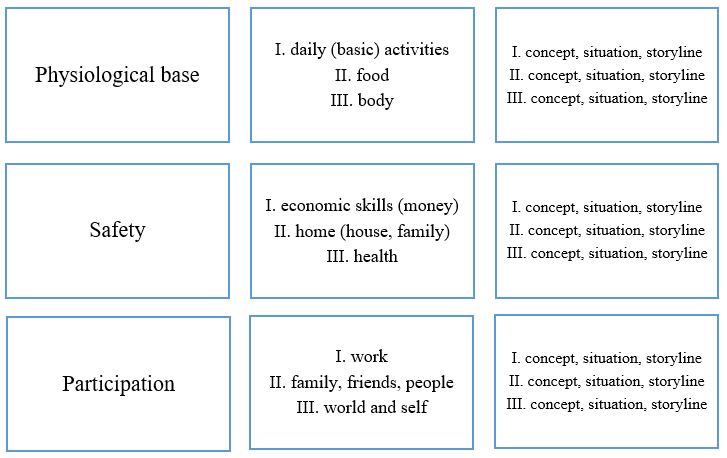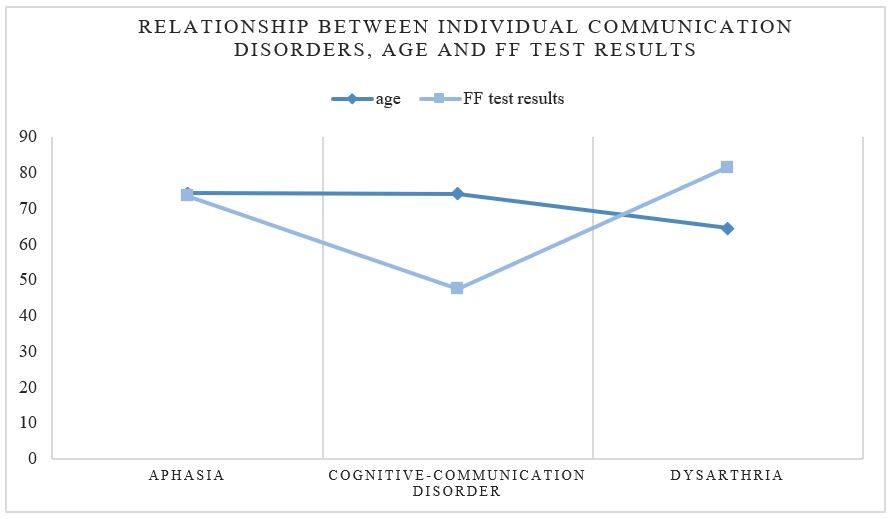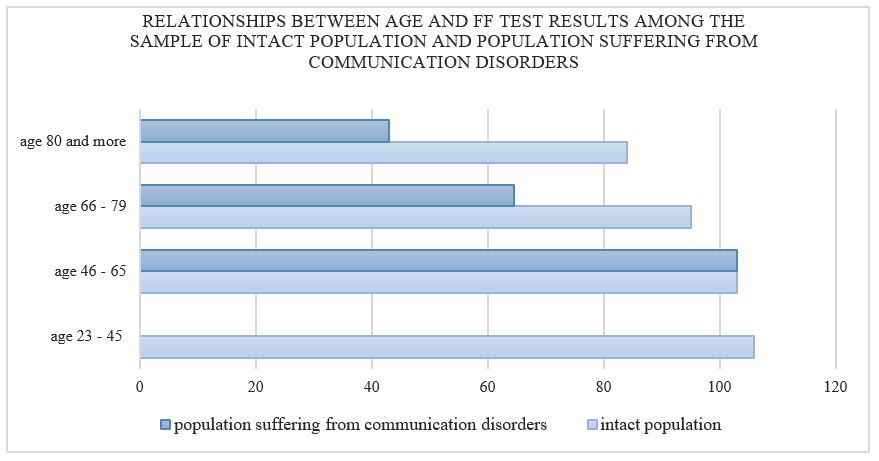Abstract
Interpersonal communication is a fundamental process in the life of a human and due to its fast development in social and cultural environment, it must be perceived as a complex concept and continuously interconnected with current knowledge across various disciplines. This article focuses on interdisciplinary relationships in information and communication technology, pedagogics, cognitive sciences and speech-language pathology. Information and communication technology should significantly participate on the process of speech-language pathology intervention. The timeliness and availability of high-quality care is particularly important in the case of loss of speech ability. The article examines a phenomenon of functional communication in adults and the elderly with communication disorder acquired during their life. The research focuses on examining this phenomenon and assessment thereof by creating a diagnostic test called “Functional Communication Photo Test” with ICT support. The goal of the study is to create an experimental version of the diagnostic test with ICT support for the assessment of client’s ability of functional communication. The Functional Communication Photo Test is based on a complex research and is a subject of a quality-focused pilot study of a group of persons with neurogenic communication disorders. In case studies we describe the relation between specific communication disorders and functional communication.
Keywords: Functional communicationICTcommunication disorders
Introduction
When examining psychical and social aspects of speech communication, it is necessary to focus on relationships between the mind, the behaviour of individuals, societies and culture. Pinker, who follows the theories of Chomsky, accentuates the importance of genetic predisposition for language development. Communication is tightly related to the physiological processes (brain, neural pathways, sensory organs), however, it exceeds such physiological framework and enters into interpersonal relationships and culture. The importance of communication in social and cultural environment is proven by several research projects focusing on the relationship of thought, language and culture, and draw the contrasting lines thereof. Language itself as a tool of communication appear to have developed through cultural transmission. (Henrich, 2016; Tomasello, 2003). Functionalists (Hopper, Givón) accentuate the moment, where it is impossible to understand a language system without a certain level of externalization. Human existence itself, is the fundamental and interconnecting point of these lines. Also, there is a dominant effort of a human to communicate from the very beginnings of history. The key importance of communication of thoughts is shown when a human loses such ability. In this case, speech-language pathology intervention participates on the rediscovery and redevelopment of all communication components with the aim to maximize communication potential of people. From the perspective of contemporary speech-language pathology as a scientific discipline, pragmatic level is one of the essential components of communication. We are unable to understand humans, if we do not observe them in their natural environment, in which they communicate (Watzslawick, Bavelas, & Jackson, 2011).
The term of functional communication
In the field of speech-language pathology, it is appropriate to emphasize the term of functional communication. It is an ability to receive or transmit communication regardless of the manner, and to communicate effectively and independently in own natural environment. For some of the authors of studies and scientific papers, the meaning of functional communication is an individual’s ability to understand and transmit information in everyday situations (Neubauer, 2018; Košťálová et al., 2015; Lind, Kristoffersen, Moen, & Simonsen, 2009; Blomert, Kean, Koster, & Schokker, 1994). Currently, the occurrence of the term functional communication is increasing in Czech speech-language pathology practice. Upon closer examination, some of its properties catch one’s eye with the lack of clarities through a database of articles and papers. The authors often substitute the term of functional communication with “pragmatic communication”. Pragmatism and linguistic pragmatism are conflicting in some definitions; this is addressed by many authors (Huang, 2017; Machová & Švehlová, 2001). Throughout the definitions however, the authors often agree that the pragmatic side of human communication is more and more frequently an object of focus of linguistics. A closer examination of the issues of communication disorders suggest that pragmatism is rather a linguistic term, while in speech-language pathology as a scientific discipline, the term functional communication is more appropriate due to its properties. In the Anglo-Saxon environment, the term functional communication is often used in the field of “Speech and Language Pathology”. In general, this phenomenon can be considered as in compliance with the description of everyday communication situations that are natural for a human and relate to the current bio-psycho-social condition (Engel, 1977). From the perspective of functional communication in speech-language pathology intervention, the most appropriate process seems to be to directly target a specific life situation of a client and assess his or her currently suppressed communication and conversational potential. Therefore, the goal is to direct intervention efforts for inter-human interaction pragmatically, helping the client to achieve a high quality of life as fast as possible, before an incident occurs. In order to do so, it is possible to take advantage in using information and communication technology as a tool for timely, high-quality, effective and motivating intervention.
Information and communication technology
Some authors describe the social character of the times we currently live in by the term “information society/civilization”, reflecting the gradually accelerating development of technology, the creation of new forms of knowledge and socio-economic systems, where information and communication technology is the dominant one (Petrusek, 2006; Milková, 2008; Zounek & Šeďová, 2009) These technologies are of an information and automation as well as an organizational nature in the society and allow both formal (company systems) and informal (social network communication) functions. Virtual information is speedily received, analysed and interacted with. Experts in the whole world share their question of who receives the data streams, who creates and spreads them, and whether the information is regulated and how and by whom. There are frequent responses to the so-called big data, trying to describe the character thereof (Waller & Fawcett, 2011; Zuboff, 2015), while the data are of significant social and cultural dimension. Authors of current research attempt to overrun the hypotheses anticipating the vision of a post-industrial society (Bell, 1974; Williams, 1982) and study the current variable factors of utilization of information and communication technology in society (Howard-Jones, Howard-Jones, Ott, M., van Leeuwen, & De Smedt, 2015; Rainie & Wellman, 2012). Turkama (2019) describes the direction of digital development, which reflects human values in terms of inclusiveness, openness and cooperation. She believes Internet should offer better services and each layer of it should focus on the human and its needs with respect to the medical care system.
Problem Statement
Application of the newest forms of ICT tools into speech-language pathology diagnostics and therapy is currently not a frequently researched phenomenon in the Czech environment. The used tools include PC and printer for speech therapists’ personal use, tablet, software for client registers, search of visual material on the Internet, software of applications for therapy, and others. The presence of the aforesaid in speech therapy clinics is often bound by other circumstances such as the awareness of speech therapists, the level of digital literacy, the financial situation of the clinic, etc. Innovating the environment of Czech speech-language pathology should be accentuated at these times and open attitude and faith in positive influence of information and communication technology should be ensured. However, this must always be in contrast with research of negative impacts of such efforts. The key factors of this process are primarily collaboration with the specialists in the team (technician, neurologist, physiotherapist, and others) and with client’s family, and taking interest in innovations in speech-language therapy (virtual reality, websites, on-line consulting, new test batteries, software for therapy).
Research Questions
The fundamental research question is: “Is the occurrence of functional communication in the population a phenomenon measurable by means of a Functional Communication Photo Test?” And if yes, it is followed by the question “How to define functional communication?”
Purpose of the Study
Continuous technology development may be the key in providing timely first aid to the client as well as successful diagnostics, creative and motivating therapy and more accurate determination of prognosis. This may be positive for both clients and workers participating on the comprehensive aid. The goal of the study is to create an experimental version of a diagnostic test that uses information and communication technology for assessment of client’s functional communication ability.
Research Methods
The tool used during the pre-research phase (2018) was the first experimental version of Functional Communication Photo Test. The FF test has been presented to experts from the ranks of physicians, nurses as well as clients of the Regional Hospital Liberec. The tool was applied to the natural environment of the hospitals. We asked the specialist and clients prepared the questions and observed how the form and methodology of the FF test is applied in practice. For example, we assessed what size and design of photos are appropriate. We identified all reactions to the test. We assessed whether the test contains methodological errors. We considered the course of the diagnostic process and adjusted communication with clients. The test was corrected many times and adapted to the final proposed design. In collaboration with the physicians, we used the patient’s condition and case documentation to exclude those from the diagnostic process. Those were particularly people at the Intensive Care Unit. During this pre-research phase at the Neurology and Neurosurgery Department, we concluded based on experts’ statements that the phenomenon of functional communication ability of closely related to everyday activities that depend on the scale of disorder and severity of medical condition. The test is entirely unsuitable for persons in severe or critical condition (Průchová, 2018; Neubauer, 2018).
Experimental version of the FF test is comprised of the following parts: a record sheet; evaluation sheet; list of test contents; the test containing visual (photographic) material. Methodology of work with the Functional Communication Photo Test is based on a comprehensive research of functional communications and on notes for successful diagnostic intervention. The diagnostic process is subject to ethical intervention, which means that we discontinue the process if the client is tired or when his mental or physical condition suddenly deteriorates. The diagnostics were carried out sensitively, with empathy and regard to client’s condition. The pilot test (2018) was carried out in clients’ natural environment of the Regional Hospital Liberec and followed the pre-research done therein. Qualitative analysis of six case studies yielded initial data regarding the condition and ability of functional communication. The crucial part was to meet the person in detail and become acquainted with the examined phenomenon and further processes. The research comprised of the following phases:
1.Research preparation (determining the research problem, questions, goals; proposing criteria for the field of research; the description of research method and technology; determining the type of data acquisition, research of relevant literature addressing the topic);
2.Execution of pre-research (obtaining field data, testing the forms and methodologies, production of first version of research tool – experimental version of “Functional Communication Photo Test”, assessment of research tool in the intended environment by experts and clients);
3.The modification of research tool (the second experimental version of the FF test) and implementation thereof in terms of a pilot study of a group of persons suffering from neurogenic communication disorders.
4.Analysis of pilot test data.
Case studies bear properties of construct validity. We utilized all available resources and documentation with the aim to prevent subjectivity, we reviewed the documentation at the Department of Neurology, Neurosurgery and Clinical Speech-Language Pathology and secured all personal information. We created a so-called “chain of evidence”, which is evidence of diagnosis based on validated and professional diagnostic processes. We asked the informants to respond to data acquired during case studies with the aim to interpret data. Internal validity has been maintained during the case studies. In the data analysis phase, we used the research to assign patterns of the given phenomenon according to its factual category. We used all of the acquired data. Additionally, the final analysis includes an explanation and justification of the study structure. In this part, we also defined and described another critical assessment of the examined phenomenon of functional communication. External validity of the research is secured by utilizing relevant expert theories describing phenomena occurring in case reports. Reliability of these studies is supported by rigorous reporting of the study research and by the critical assessment of possible data collection errors, data distortion and other discrepancies during direct study implementation (Yin, 2014; Stake, 1995; Neubauer, 2018)
Findings
Case study data were collected by means of the FF test experimental version. It comprises of a record sheet; evaluation sheet; list of test contents; the test containing visual (photographic) material. Topics and partial test tasks are based on the Common European Framework of Reference for Languages (2001).

A properly taken photo captures the reality as it could really be seen under the premise of intactness. A photo for research and documentary purposes satisfies this need. The resulting photo must be as realistic as possible in the test. When showing individual objects, these should be shown in minimalistic environment. Using a photographic atelier with white background, suitable lenses and maintaining other technicalities is crucial. The photos must be coloured, bright and sharp. Contrary to that, images showing a story should be natural, the shown activities should be well known and have an everyday nature.

In case reports, we described the relationship between individual communication disorders of clients and their functional communication abilities. Profile of this ability is different for each disorder. The analysis of individual cases depended on a personal subjective selection of three cases and objective chance, i.e. the presence of three other clients of the neurology and neurosurgery outpatient clinic at the time of diagnostics. In order to obtain the resulting pilot test, we were able to visit up to 13 clients. However, some of them refused the diagnostic process and the medical condition of some of the other patients deteriorated to such extent we were unable to carry out the diagnostic process.
The case studies include a comparison of relationship between individual diagnosed communication disorders from the perspective of aetiology thereof and functional communication. In the first case study, we compare the relationship of epilepsy syndrome and the accompanying communication disorders with the condition of functional communication. In the second case study, we describe the relationship between expressive stroke-related facial disorder with functional communication. The status of functional communication in the third case study must be assessed in connection with the presence of minor anomic aphasia and an overall post-stroke condition. The fourth case study contains analysis of functional communication and expressive stroke-related aphasia and dysarthria. The fifth case study focuses on the relationship between dysarthria and functional communication. In the last case study, the sixth one, we try to carry out a comprehensive analysis of the severity of dementia syndrome caused by cancer with regard to functional communication.
The assessment of all case reports suggests that the functional communication profile may differ with individual disorders. The relationships between individual communication disorders, age and FF test results are shown below (Průchová, 2018).

The Functional Communication Photo Test has been indicatively tested with an intact group of twenty people. The following graph shows available information.

Data analysis in the case studies shows the test as a tool used primarily for the diagnostics of cognitive states and consequences thereof in everyday life. So far, the experimental version of the test does not examine the true conversational abilities of clients with neurogenic communication disorders. The spectrum of the functional communication itself is much broader than assessed by the FF test or other already existing tests. This issue is to be a subject to further research and extension. Multiple tests may also be used during the diagnostics and their results compared, etc. And finally, for the sake of continuity of diagnostic material and therapeutic intervention, it would be suitable to design a functional communication that would be based on the FF test and would use photographic material with open distribution license at a website. Creation of such website will be a subject to further research. The website would also be used as a source of information and be educational for experts as well as for clients’ families and the general public. Functional communication intervention would become complex this way and might have an innovative effect throughout the whole process of speech-language pathology diagnostics and would try to maximize communication potential and potential for high quality of life of people with severe communication disorders acquired during adulthood and old age.
Conclusion
Research of functional communication is far more traditional abroad than in the Czech environment. Fundamental contributions on the topic of functional communications were made by Butt and Bucks (2004), Holland, Frattali and Fromm (1999), Hilari and Cruice (2011), Sarno (1969), O'Halloran, Worrall, Toffolo, Code and Hickson (2004), Worral (1999). In the course of time, it would be wise to allocate more resources to research of this phenomenon, not only in the discipline of speech-language pathology. The situation where interest in functional communication penetrates all disciplines is proved to be essential for clients with severe disorders and diseases. Inter-disciplinary cooperation is necessary for this specific discipline. Including information and communication technology into the research allows the implementation thereof. Its current form as a tool is media utilization – 2D digital image (cf. Milkova, Manenova, Chadimova, & Ntalianis, 2019). Results acquired by the final analysis of the case studies selected for pilot test as a research method are merely indicative yet can be used to design a final version of the test. The experimental research tool called “Functional Communication Photo Dictionary” might be used in the future for finding out whether the client is ready to return home after a difficult treatment and intervention. At the same time, information and communication technology might be used on more frequent basis during the implementation of other research phases. Using virtual reality is one of the possible options. This article also accentuates the necessity of ensuring higher quality of post-acute care in the Czech Republic.
Acknowledgments
Authors of this article would now like to thank MUDr. Zuzana Marečková and the whole team of the Department of Outpatient Speech-Language Pathology, Neurology and Neurosurgery at the Regional Hospital Liberec for their help and willingness during validation of the designed Functional Communication Photo Test. Sincere thanks also go to clients of these departments for their help and willingness to become a part of authors’ research.
References
- Bell, D. (1974). The Coming of Post-Industrial Society. New York, NY: Harper Colophon Books.
- Blomert, L., Kean, M-L., Koster, C., & Schokker, J. (1994). Amsterdam-Nijmegen Eveeryday Language Test: Construction, reliability and valididty. Aphasiology, 8, 381-407.
- Butt, P., & Bucks, R. (2004). BNVR: The Butt Non-Verbal Reasoning Test: Bicester: Speechmark.
- Council of Europe. (2001). Common European framework of reference for languages: Learning, teaching, assessment. Cambridge, UK: Press Syndicate of the University of Cambridge.
- Engel, G. L. (1977). The need for a new medical model: A challenge for biomedicine. Science, 196, 129-136.
- Henrich, J. (2016). The Secret of Our Success: How Culture Is Driving Human Evolution, Domesticating Our Species, and Making Us Smarter. Princeton: Princeton University Press.
- Hilari, K., & Cruice, M. (2011). Quality of life approach to aphasia. In I. Papathanasiou, P. Coppens, C. Potagas (Eds). Aphasia and related neurogenic communication disorders. Burlington: Jones and Barlett Learning.
- Holland, A. L., Frattali, C., & Fromm, D. (1999). Communicative activities in daily living (CADL‑2). Austin, TX: Pro-Ed.
- Howard-Jones, P., Howard-Jones, P., Ott, M., van Leeuwen, T., & De Smedt, B. (2015). The potential relevance of cognitive neuroscience for the development and use of technology-enhanced learning. Learning, Media and Technology, 40(2), 131–151.
- Huang, Y. (Ed.) (2017). The Oxford Handbook of Pragmatics. London, UK: Oxford University Press.
- Lind, M., Kristoffersen, K. E., Moen, I., & Simonsen, H. G. (2009). Semi-spontaneous oral text production: Measurements in clinical practice. Clinical Linguistics & Phonetics, 23(12), 872–886.
- Machová, S., & Švehlová, M. (2001). Sémantika a pragmatická lingvistika [Semantics and pragmatic linguistics]. Praha: PedF UK.
- Milková, E. (2008). Multimedia Applications and their Benefit for Teaching and Learning at Universities. WSEAS Transactions on Information Science & Applications, 5(6), 869-879.
- Milkova, E., Manenova, M., Chadimova, L., & Ntalianis, K. (2019). 3D Technology in the Cultural Heritage and Education Context. International journal of education and information technologies, 13, 59-64.
- Neubauer, K. (ed.). (2018). Kompendium klinické logopedie. Praha: Portál.
- O'Halloran, R., Worrall, L., Toffolo, D., Code, C., & Hickson, L. (2004). IFCI: Inpatient functional communication interview. Oxon: Speechmark.
- Petrusek, M. (2006). Společnost pozdní doby. Praha: Sociologické nakladatelství.
- Průchová, Z. (2018). Využití funkcí specializovaného webového portálu pro rozvoj diagnostiky a terapie získaných poruch řečové komunikace. Hradec Králové: Pedagogická fakulta Univerzity Hradec Králové.
- Rainie, L., & Wellman, B. (2012). Networked: The New Social Operating System, Cambridge, MA: MIT Press
- Sarno, M. T. (1969). The functional communication profile: manual of directions. New York: Institute of Rehabilitation Medicine, New York University Medical Center.
- Stake, R. E. (1995). The art of case study research. Thousand Oaks, CA, US: Sage Publications, Inc.
- Tomasello, M. (2003). Constructing A Language: A Usage Based Theory of Language Acquisition. Cambridge, MA: Harvard University Press.
- Turkama, P. (2019). Building Inclusive Digital Societies Through the Use of Open Source Technologies. In: Y. Baghdadi, A. Harfouche (Eds) ICT for a Better Life and a Better World. Lecture Notes in Information Systems and Organisation (vol 30). Springer, Cham.
- Waller, M., & Fawcett, S. (2011). Switching Our Lenses for New Perspectives: A Prescription for Writing and Reviewing Out of Your Comfort Zone. Journal of Business Logistics, 32(3), 209-2013.
- Williams, F. (1982). The communications revolution. Beverly Hills: SAGE Publications.
- Worral, L. (1999). Functional communication therapy planner. Bicester: Winslow Press Ltd.
- Yin, R. K. (2014). Case study research: Design and methods (4th Ed.). Thousand Oaks, CA: Sage.
- Zounek, J., & Šeďová, K. (2009). Učitelé a technologie: Mezi tradičním a moderním pojetím [Teachers and technology: between a traditional and a modern approach]. Brno: Paido.
- Zuboff, S. (2015). Big Other: Surveillance Capitalism and the Prospects of an Information Civilization. Journal of Information Technology, 30, 75–89.
Copyright information

This work is licensed under a Creative Commons Attribution-NonCommercial-NoDerivatives 4.0 International License.
About this article
Publication Date
07 November 2019
Article Doi
eBook ISBN
978-1-80296-071-6
Publisher
Future Academy
Volume
72
Print ISBN (optional)
-
Edition Number
1st Edition
Pages
1-794
Subjects
Psychology, educational psychology, counseling psychology
Cite this article as:
Pruchova, Z., & Neubauer, K. (2019). Utilization Of Information And Communication Technology In Speech-Language Pahology Intervention. In P. Besedová, N. Heinrichová, & J. Ondráková (Eds.), ICEEPSY 2019: Education and Educational Psychology, vol 72. European Proceedings of Social and Behavioural Sciences (pp. 264-273). Future Academy. https://doi.org/10.15405/epsbs.2019.11.24

